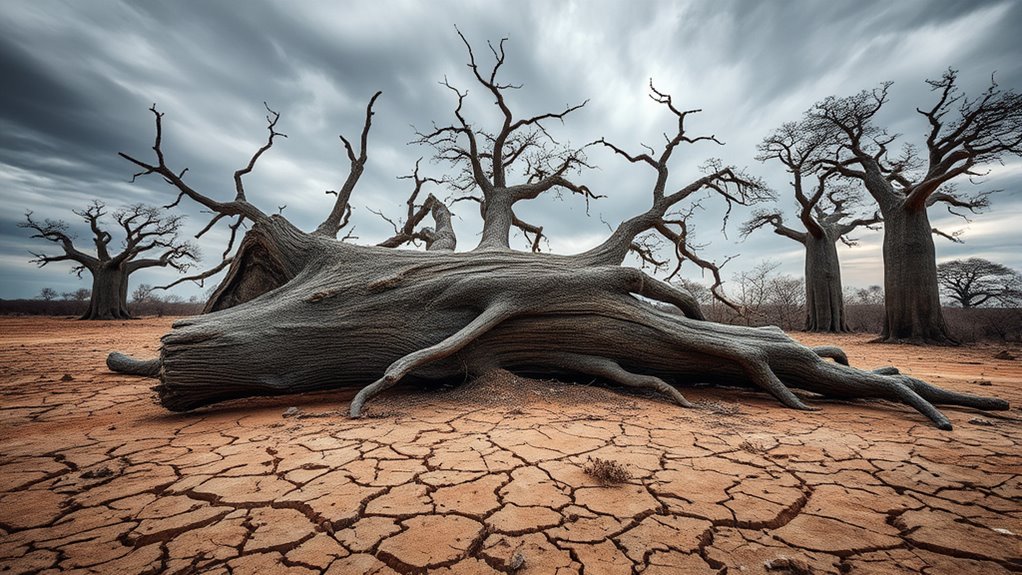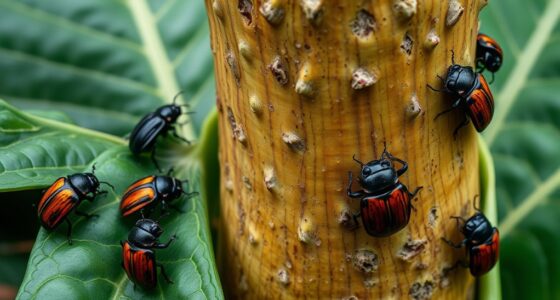You may have noticed that Africa’s ancient baobabs are collapsing, which is caused by climate change, with more frequent droughts and rising temperatures weakening these iconic trees. Human activities like land clearing and logging also damage their habitats. As drought and disease spread, these once-invincible giants are falling at an alarming rate, highlighting ecological stress. To discover how these stunning trees are struggling and what’s being done to save them, keep exploring this critical issue.
Key Takeaways
- Climate change-induced droughts, higher temperatures, and unpredictable rainfall weaken baobabs, making them more vulnerable to disease and decay.
- Human activities like land clearing and urban development damage habitats and accelerate the decline of these ancient trees.
- Fungal infections, pests, and mysterious wounds rapidly deteriorate weakened baobabs, causing them to fall prematurely.
- The widespread loss of baobabs signals ecological imbalance and environmental stress affecting entire ecosystems.
- Conservation efforts are critical to protect remaining baobabs and address the underlying causes of their decline.

Baobab trees, known for their massive trunks and centuries-long lifespan, are suddenly falling across parts of Africa and Australia. This alarming trend catches your attention because these giants have long symbolized strength, endurance, and cultural significance. As you look closer, you realize that these iconic trees, which once seemed invincible, are succumbing at an unprecedented rate. It’s not just a few isolated incidents; entire populations are affected, leaving communities and scientists puzzled. You might wonder, what’s causing these ancient beings to collapse?
Ancient baobabs are rapidly falling, signaling environmental stress and urgent need for conservation efforts.
The reasons behind this decline are multifaceted. Climate change plays a significant role, bringing unpredictable droughts, higher temperatures, and shifting rainfall patterns that stress the trees’ ability to survive. Baobabs are adapted to specific climate conditions, and when those change rapidly, it weakens their resilience. Increased droughts dry out their roots and bark, making them more vulnerable to disease and decay. You also find that human activity compounds the problem. Land clearing for agriculture, urban development, and logging directly harms these trees, often removing their habitat altogether. In some cases, local communities have removed older, hollowed-out trees because they are considered hazards, unknowingly accelerating their decline.
Scientists are racing to understand whether diseases play a part. Recent studies suggest that fungal infections and pests are attacking weakened trees, further hastening their fall. Some baobabs have developed mysterious, gaping wounds, and others show signs of rot that spread rapidly once the tree’s defenses are compromised. The situation is dire because these trees are not just ecological landmarks but also cultural repositories. Their hollows serve as homes for animals and storage for water during droughts, making their loss even more impactful to local ecosystems and communities. Additionally, the increasing frequency of drought conditions, which can be linked to climate change, exacerbates their decline.
You might feel a mix of concern and urgency as you realize that the fate of these ancient trees could symbolize broader environmental issues. The decline of baobabs acts as a warning sign about the health of the entire ecosystem. Efforts are underway to monitor their health, protect remaining specimens, and understand the underlying causes better. Yet, time is running out. The loss of these old giants isn’t just about losing trees; it’s about losing a crucial part of natural history and cultural heritage. If you want to help, supporting conservation initiatives and raising awareness about climate change’s impact on these majestic trees become essential steps. The future of Africa’s oldest trees depends on immediate action and a collective commitment to preserve what remains of these awe-inspiring giants.
Frequently Asked Questions
Are Baobab Trees Endangered or Protected by Law?
You should know that baobab trees are increasingly endangered due to climate change, deforestation, and overharvesting. While some countries have started protecting them by law, enforcement varies, and many trees still face threats. You can help by supporting conservation efforts and raising awareness about their importance. Laws exist in certain regions, but ongoing protection and sustainable practices are vital to guarantee these iconic trees survive for future generations.
How Does Climate Change Specifically Affect Baobab Longevity?
Climate change impacts baobab longevity by increasing temperatures and altering rainfall patterns. You might notice these trees struggle to survive as droughts become more frequent and severe, stressing their roots and reducing water availability. Higher temperatures can also speed up aging processes, making it harder for them to produce seeds and regenerate. If these conditions continue, baobabs could decline faster, risking their survival and the ecosystems they support.
Can Baobab Trees Be Replanted or Cultivated Elsewhere?
Yes, you can replant or cultivate baobab trees elsewhere. You should gather healthy seeds, plant them in well-drained soil, and keep them warm and moist. It takes patience, as baobabs grow slowly, but with proper care, they can thrive in suitable climates outside Africa. However, make certain you follow local conservation laws and consider the ecological impact before relocating these iconic trees.
What Cultural Significance Do Old Baobabs Hold in Africa?
Old baobabs are like living legends, holding deep cultural significance in Africa. You might think they’re just trees, but locals see them as sacred symbols, storytellers, and community anchors. They’re witnesses to history, offering shade, wisdom, and spiritual connection. If you ignore their importance, you risk losing not only nature’s wonders but also the cultural roots that tie communities together—because, after all, even trees have stories worth listening to.
Are There Conservation Efforts Focusing on Preserving These Ancient Trees?
Yes, conservation efforts are underway to preserve these ancient trees. You can support local initiatives and organizations dedicated to protecting baobabs by raising awareness, donating, or participating in community projects. Some countries have established protected areas and legal frameworks to safeguard these iconic trees from deforestation and climate change. Your involvement helps guarantee that future generations can enjoy and learn from these natural monuments, maintaining their cultural and ecological significance.
Conclusion
As you see these ancient giants falling, it’s clear their decline signals broader environmental shifts. Did you know that some baobabs are over 6,000 years old? Their disappearance isn’t just about losing iconic trees; it reflects climate change’s profound impact on Africa’s ecosystems. Protecting these remarkable giants matters—not just for their history but for the future health of the continent’s environment. Your awareness can help drive efforts to preserve these irreplaceable symbols of Africa’s natural heritage.










